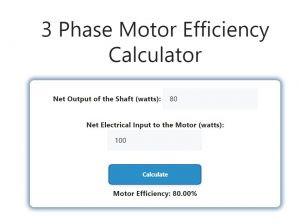About 3 Phase Motor Efficiency Calculator (Formula)
The 3 Phase Motor Efficiency Calculator is an essential tool for engineers and technicians working with three-phase electric motors. Understanding motor efficiency is crucial for ensuring optimal performance, reducing energy consumption, and lowering operational costs. This calculator allows users to determine the efficiency of a 3-phase motor by comparing the output power to the input power. By accurately calculating motor efficiency, users can make informed decisions regarding motor selection, operation, and maintenance. In this article, we will explore the formula for calculating 3-phase motor efficiency, provide step-by-step instructions on how to use the calculator, and address common questions related to motor efficiency.
Formula
The formula for calculating 3-phase motor efficiency is: E3p = NO / NI * 100, where E3p represents the efficiency of the 3-phase motor, NO is the output power, and NI is the input power.
How to Use
To use the 3 Phase Motor Efficiency Calculator effectively, follow these steps:
- Determine the Input Power (NI): This is the total electrical power supplied to the motor, typically measured in watts or kilowatts.
- Measure the Output Power (NO): This is the mechanical power delivered by the motor to the load, also measured in watts or kilowatts.
- Input Values: Enter the values for NI and NO into the calculator.
- Calculate Motor Efficiency: Use the formula E3p = NO / NI * 100 to compute the efficiency percentage.
Example
Let’s consider an example where a 3-phase motor has an input power of 10,000 watts and an output power of 8,000 watts.
- Input Values:
NI = 10,000 watts
NO = 8,000 watts - Apply the Formula:
E3p = NO / NI * 100
E3p = 8,000 / 10,000 * 100
E3p = 0.8 * 100
E3p = 80%
In this case, the efficiency of the 3-phase motor is 80%, indicating that 80% of the input power is converted into useful mechanical power.

FAQs
- What is the 3 Phase Motor Efficiency Calculator?
It is a tool used to calculate the efficiency of three-phase electric motors based on their input and output power. - Why is motor efficiency important?
High motor efficiency reduces energy consumption, lowers operational costs, and enhances performance. - What does NO stand for in the formula?
NO stands for Output Power, which is the mechanical power delivered by the motor. - What does NI stand for in the formula?
NI stands for Input Power, the total electrical power supplied to the motor. - How is motor efficiency expressed?
Motor efficiency is typically expressed as a percentage. - What is considered a good motor efficiency percentage?
Generally, motor efficiencies above 80% are considered good, with high-efficiency motors exceeding 90%. - Can this calculator be used for different types of motors?
This calculator is specifically designed for three-phase motors; other types may require different considerations. - What factors can affect motor efficiency?
Factors include load conditions, motor design, operating temperature, and maintenance. - How can I improve motor efficiency?
Regular maintenance, proper sizing, and operating under optimal conditions can help enhance motor efficiency. - Is it necessary to calculate motor efficiency regularly?
Yes, regular calculations can help identify performance issues and guide maintenance efforts. - Can load changes affect motor efficiency?
Yes, operating a motor under different loads can change its efficiency. - How does temperature affect motor efficiency?
Higher temperatures can lead to increased losses in a motor, thereby reducing efficiency. - What is the impact of poor maintenance on motor efficiency?
Lack of maintenance can lead to increased friction, heat, and losses, negatively affecting efficiency. - How do I measure input and output power accurately?
Input power can be measured using power meters, while output power may require torque and speed measurements. - What should I do if my motor’s efficiency is low?
Investigate potential causes such as overloads, misalignment, or inadequate maintenance. - Can motor efficiency vary with speed?
Yes, efficiency can change depending on the operating speed of the motor. - How do variable frequency drives affect motor efficiency?
Variable frequency drives can enhance efficiency by optimizing the motor’s speed for varying load conditions. - Is there a maximum efficiency for motors?
While there is no strict maximum, efficiencies above 95% are common for high-efficiency motors. - What is the relationship between efficiency and power factor?
A high power factor often indicates better efficiency, as it means more of the input power is used effectively. - Can I use this calculator for energy audits?
Yes, this calculator can be a helpful tool in energy audits to assess motor performance and identify opportunities for improvement.
Conclusion
The 3 Phase Motor Efficiency Calculator is a crucial tool for engineers and technicians seeking to optimize the performance of three-phase motors. By accurately assessing motor efficiency, users can make informed decisions regarding motor selection, operation, and maintenance. Understanding the relationship between input and output power helps improve energy efficiency and reduce operational costs. Regularly calculating motor efficiency not only contributes to better performance but also promotes sustainable practices in electrical engineering and industrial applications. Utilizing this calculator empowers professionals to enhance the reliability and efficiency of their motor-driven systems.